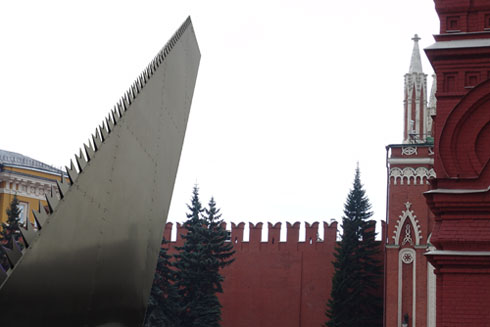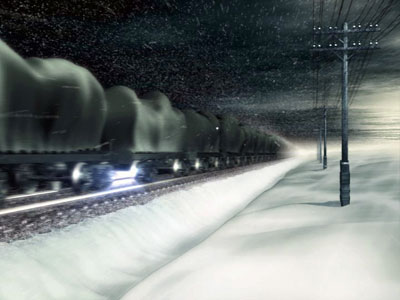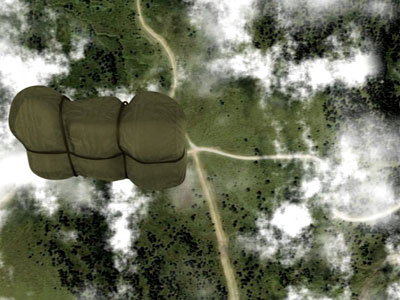Nostalgic Artifice – Modus R
Art Basel Miami Beach, Miami, December 04-12, 2006
We need to place ourselves in an area where politics and art are intertwined, where the resistant force of politics and the creative forces of art mutually affect each other, blurring the frontiers between them.
–Suely Rolnik, “The Twilight of the Victim: Creating Quits Its Pimp, to Rejoin Resistance.”(S. Rolnik, “The Twilight of the Victim: Creation Quits Its Pimp, to Rejoin Resistance,” Zehar, no.51, (2003):36. www.arteleku.net.)
“Young and energetic” was the description that Alexander Esin gave to a group of Russian artists in his preface to the 2006 Art Basel Miami Beach exhibition catalog. The show was aptly titled Modus R, where “modus” stands for “form” and “method,” and “R” can be interpreted as either “Russia” or “rational.”
This exhibition presented a conceptual investigation into the formal qualities of selected art objects. The Curators, Olesya Turkina and Eugenia Kokodze, made the premise that formalism today is an artistic reflection on the “trauma of victory” that occurred in Russia with the events of the 1990s. On the surface, the exhibition’s emphasis is on “pure” and ambiguous form. This is a refutation of the political and social context that has appeared periodically in the discourse of Western art from the beginning of the 20th century to the 1970s. Such formalism in Russian art is associated with the avant-garde. Russian unofficial artists of the 1970s also appropriated the dynamic language of Suprematist form, seeking reinvigoration from the geometric shapes of modernity. Artists of the 1990s explored historical parallels with the revolutionary force of the early 20th century. After almost fifteen years of transition to a market economy, Modus R intended to reestablish still-valid connections between contemporary art and the avant-garde. The curators argued that modernism experienced a second coming during the 1970s.
It’s not surprising that the artists presented in this show chased the oblique memorabilia of the Soviet past. On close examination, it became apparent that they scrupulously reconstructed the dismal aesthetics of Socialism; by doing so they nostalgically sought a revival of that time. And if the state of melancholia manifests itself as identification with the subject of grief, it is then accurate to conclude that the artists represented in this show Modus R are immersed in a melancholic longing for the dreary time before Perestroika.
It was surprising that even a young artist such as Vadim Logutov (b.1980) revisited a reality that he could only have heard about through stories from members of the older generation. In his video, Twilight (2005) Logutov showed a dreary and claustrophobic suburban crosswalk soaked in endless rain. Similarly, Piotr Bely (b. 1971) reconstructed a derelict wall frame, using original materials found in Danger Zone, from the series Memorial Model-Making. (2006). This crumbling installation can be read as a metaphor for Soviet architecture. When viewed on a larger scale, the work encompasses the dilapidation of the Soviet Union before the upheavals of the 1990s. Both works presented post-heroic reminders of a Soviet past that these artists could hardly remember.
Upon entering the exhibition space at the Newton Building in the heart of Miami’s Design District, the visitor was greeted by Alexey Osmolovsky’s wall text, which began: “When political ambition becomes design…” This statement lamented the zeitgeist of the 1990s which has now been replaced by democratic procrastination and the rise of an affluent middle class. When the hopes of the 1990s faded with the ushering in of a ruthless market economy and the invasion of global pop-culture, artists abandoned their vanguard positions.The accent on anti-aesthetic and coarse appearance in the art works exhibited at the Modus show was an artistic choice that ran counter to the proliferating imagery of glamour, consumerism, and wealth that has “colonized” Russian art of today.
In answer to my question about the constant recycling of grim Soviet iconography, Craig Robbins, the urban developer, art collector, president of the American design group Dacra, and the sponsor of the exhibition, replied that, “Art is not always made to be pretty.”
The most baffling installation in the show was Zhanna Kadyrova’s Diamonds (2006). Kadryova is a young Ukranian artist (b. 1981) who was involved in the Orange Revolution of 2004 but has now turned to formal experimentation rooted in industrial aesthetics. Her ten rectangular multi-faceted objects made of colorful tiles were crudely joined together by cemented seams following a gemstone silhouette. Everything that diamonds are not was presented in these makeshift sculptures.
Intentionally unattractive, the surfaces were roughly finished, and while the artist intended them to be self-referential orthogonal shapes, they nevertheless failed to have an impact. Compared to Kadryova, Anatoly Osmolovsky’s formal inquiry was more successful. In his sculptural molds entitled Hardware (2006), the artist hinted at the shape of modern tanks that were built in only a few countries around the world. Diminished to the form of gleaming statuettes, his eleven bronzes of tanks became an ironic expression of global militarism. It is for that playful reason that the artist used bronze, the metal of “high” art and modernism.
Another project that displayed both conceptual and technical sophistication was the computer-animated video Echelon (2006) by the group Blue Soup. Comprised of three reverse projections, with the third being placed on the floor, the video featured what seemed to be an endless line of military transportation. An infinite flow of railway carriages cutting through snowy terrain was projected on the left, while the opposite wall displayed military trucks going through a summery field. Both convoys carried identical bundles of unidentifiable army goods — packs of ammunition, provisions, or other military equipment. On the floor, similar cargo bundles were filmed as they parachuted down from an invisible plane. A loud humming sound accompanied this loop of frightening imagery and presented a powerful account of “pure war”. Here, any associations with formalism were contradicted by the video’s strong political subtext.
 In the park outside of the gallery, a special project titled Saw (1999-2005) by Andrei Filippov (b. 1959) delivered a ravenously toothed stainless steel saw that was embedded in the ground and extended thirty feet high. Forged in a manner similar to the pattern of the thorny silhouette of the walls of the Kremlin, the sculpture was also presented as a “sharp” monument symbolizing the division between the East and West. Read as a sword or a phallic symbol, the sculpture denoted the masculine power of “Russia-ness”projected into the realm of the Western art market. Whatever its significance, the obelisk looked ridiculously outmoded as it gleamed in the Florida sun.
In the park outside of the gallery, a special project titled Saw (1999-2005) by Andrei Filippov (b. 1959) delivered a ravenously toothed stainless steel saw that was embedded in the ground and extended thirty feet high. Forged in a manner similar to the pattern of the thorny silhouette of the walls of the Kremlin, the sculpture was also presented as a “sharp” monument symbolizing the division between the East and West. Read as a sword or a phallic symbol, the sculpture denoted the masculine power of “Russia-ness”projected into the realm of the Western art market. Whatever its significance, the obelisk looked ridiculously outmoded as it gleamed in the Florida sun.
In the context of the post-Soviet condition that presumes to bring Russia and the US together, the explicit citation of the confrontations of the Cold War seemed rather passé, and Nick Iljine’s comments in this regard are surprisingly optimistic. Iljine refers to Filippov’s sculpture as “an exemplar of a new generation of Russian culture.” One would only wish to see more innovative forms and implementations of this “new generation” than those lauded by Iljine.
Does Modus R imply nostalgia for the Communist past? The show was indeed a space where the ephemera of the Soviet past became a spectacle. Soviet history was “re-heated” for the buyer’s interest. Like quotidian souvenirs, the “Soviet grunge” was repackaged for sale in multiple forms. Russian art is on the global market already. At this carnivalesque fair, history became merchandise and the past was discounted in favor of a quick deal.
Traumatized by the speed of the 1990s and their aftermath, the artists represented at Modus R were clearly worn out by almost two decades of transition. They shied away from the present social context and disappeared into explorations of the art objects’ formal components. In this way, they shunned the forceful demands that the market imposes on artists and craftsmanship. The advent of Modus R and the massive presence of Russian galleries at the fair circuit is evidence that Russian artists intend to take a significant part in global art production. Fittingly, Olesya Turkina argues that “contemporary art has entered into a fourth awakening phase that could be differentiated by following the merciless rules of the art market.”(Olesya Turkina, “Freedom and the West: Shifting Meaning in Post-Soviet Culture,” conference papers, Brazil, July 2001.)
At the same time, Modus R hid behind an institutional shield of “not-for-sale” and “non-profit” type labels.
This kind of self-promotion acted on the principle that high art is not for sale. Given legitimacy by the curators who were not challenged by the crowd of art buyers, the show didactically imposed its deceptive agenda, a formal trick. In addition, the exhibition received a thrill factor from the same PR agencies that publicized the Art Fair and by the thirteen Russian journalists who were flown in to review the event. Consequently, the exhibition’s value was heightened.(Lindsay Pollock, “Russian Collectors, Dealers Boot Profile at Miami Art Fair,” Boomerang.com December, 08 2006, www.bloomberg.com/apps/news.)
What is this for, if not to rehearse Craig Robins’ statement that Modus R was impressive in “both the quality and the breadth”?
The homogeneous art world and its cultural capital that moves between international events such as Biennales and Documentas still leaves Russia behind in its creative swell. Because of its centralized politics and funding, and the lack of a non-profit infrastructure as well as independent art critics Russian art is limited to its parochial and exclusive scene. Once these predicaments of socio political transition from a post-Soviet condition into a new market state have been overcome, the politics of art will be decentralized, and elitism will give way to a plurality of artistic expression. remote sensing of vegetation – the new way of smart farming






